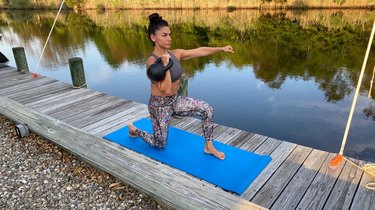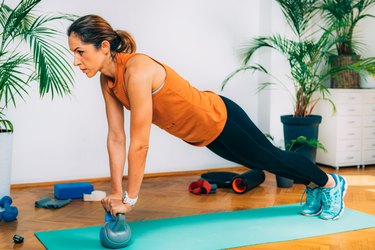
Some days, it feels hard enough to get up off the couch and stand up, period. Now try starting on the ground with a kettlebell in tow.
Yes, the Turkish get-up (TGU) is challenging — taking you from lying down to a full standing position with a kettlebell overhead. It's also one of the single most beneficial, functional strength exercises you can do. So you'd be wise to try it out.
Video of the Day
Here's the thing: The compound exercise isn't just a muscular challenge. It has a slew of different, well-coordinated steps. So before you start lifting heavy weights, you need to learn how to do the Turkish get-up exercise with safe, effective form.
But don't worry. Practice is all you need to build your muscle memory and rock the move like the well-oiled machine you are.
How to Do the Turkish Get-Up
TGU
- Lie in the fetal position on the ground, facing your right side. Hold a kettlebell in your right hand, with your arm bent and the kettlebell in the "racked" position, meaning the ball portion is resting against the back of your hand and wrist.
- Roll over toward the left to lie face up, putting both feet on the ground with your knees bent.
- Straighten both arms upward, pressing the kettlebell straight up over your shoulder.
- Lower your left arm and leg to your left side, both at a 45-degree angle from your body.
- Keep your eyes on the kettlebell and your right arm straight up over your shoulder throughout the entire exercise.
- Roll onto your left elbow, bringing your right shoulder off the ground. Keep the kettlebell straight over your shoulder.
- Keep your hips on the ground as you straighten your left arm and corkscrew your hand into the found, pushing your torso further upright.
- Reposition your right foot so that you can support your weight on your left hand and your right foot, using your core to keep your body steady.
- Press through your right foot to raise your hips off the ground. Bring your left leg underneath you and slightly behind your hips, so that you can kneel on your left knee. The ball of your left foot should be in contact with the ground.
- Shift your torso to get into a lunge position with your left knee still on the ground. This will bring your left hand off the ground, while the kettlebell remains straight up over your right shoulder.
- Stand up, bringing your left leg forward so that you end up with your feet hip-width apart.
- Reverse the motion, step by step, to end lying face-up on the ground.
- Carefully bend your right arm and bring the kettlebell back to the ground to complete the repetition, using your left arm for an assist as needed.
How Heavy Should Your Kettlebell Be?
When learning the exercise, use the lightest weight you have available. As you get more comfortable coordinating the move, increase the weight to one that challenges you, but still allows you to do all of your reps with solid form.
Because each TGU rep is so long and involved, you only need to do 2 to 4 reps per set to start, according to the American Council on Exercise. Start with 1 set and increase from there as you feel ready.
3 Turkish Get-Up Benefits
1. Total-Body Strength
The TGU works everything you've got — legs, hips, core, back, chest, shoulders, arms, says Lacee Lazoff, CPT, a certified personal trainer and kettlebell coach based in New York City.
It also teaches each of those muscle groups to work together as a cohesive unit.
2. Mobility and Stability
The full-body move challenges you in all sorts of bendy, twisty ways. And by taking your joints through their full ranges of motion — and in multiple planes of movement — Turkish get-ups can help preserve and build your mobility through the decades.
Plus, because TGUs involves a healthy dose of instability, it helps build the hip, core, spinal and shoulder stability you need to reduce your risk of injury, according to Lazoff.
3. Cardio Conditioning
Do even just one rep of the TGU, and your heart and lungs will be pounding. As the exercise works all of your body's major muscle groups, your cardiorespiratory system works to get blood and oxygen to those muscles.
That's especially good news for people who don't love traditional cardio workouts.
Try These 5 Turkish Get-Up Variations
Master the move and keep your body growing with these tweaks, listed from beginner to advanced.
1. Use Only Your Body Weight
It's critical for beginners to master the movement pattern of the get-up before adding weight. Practice doing the exercise without a kettlebell (and your raised hand in a fist), Lazoff says. When that feels right, you can pick up a weight.
2. Break Up the Move
If you don't feel comfortable doing the movement in its entirety, do bits and pieces. Once you master each step individually, you can string them together.
Focus on the portions that commonly trip people up. "I see a lot of people in the gym struggle with stepping up from the lunge or stepping back down into it on the reverse," Lazoff says. "This phase requires some solid hip and adductor strength."
3. Hold a Dumbbell
The kettlebell Turkish get-up isn't the only get-up you can do. Using a dumbbell works just fine, and can actually challenge your shoulder stability a bit more.
That's because, with kettlebells, the weight hangs partway down the back of your forearm. With dumbbell get-ups, the weight is in line with your fist. The higher the weight, the less stability you have.
4. Add an Extra Press
To advance the TGU and further build your shoulders, you can integrate one or two overhead presses to the move.
In either the kneeling or standing position, bring the kettlebell to your chest, then press it back up over your head before continuing with the movement as usual.
5. Keep Your Arm Raised
Complete multiple reps without returning the kettlebell to your chest. "That will be a challenge for sure," working both your shoulder stability and endurance, Lazoff says.
Just don't compromise your form. If your arm starts to wander, lower the weight and get some rest.
Was this article helpful?
150 Characters Max
0/150
Thank you for sharing!
Thank you for your feedback!



